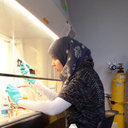Bioactivities of volatile components from Nepalese Artemisia species.
Keywords
Abstract
The essential oils from the leaves of Artemisia dubia, A. indica, and A. vulgaris growing wild in Nepal were obtained by hydrodistillation and analyzed by GC-MS. The major components in A. dubia oil were chrysanthenone (29.0%), coumarin (18.3%), and camphor (16.4%). A. indica oil was dominated by ascaridole (15.4%), isoascaridole (9.9%), trans-p-mentha-2,8-dien-1-ol (9.7%), and trans-verbenol (8.4%). The essential oil of Nepalese A. vulgaris was rich in alpha-thujone (30.5%), 1,8-cineole (12.4%), and camphor (10.3%). The essential oils were screened for phytotoxic activity against Lactuca sativa (lettuce) and Lolium perenne (perennial ryegrass) using both seed germination and seedling growth, and all three Artemisia oils exhibited notable allelopathic activity. A. dubia oil showed in-vitro cytotoxic activity on MCF-7 cells (100% kill at 100 microg/mL) and was also marginally antifungal against Aspergillus niger (MIC = 313 microg/mL). DFT calculations (B3LYP/6-31G*) revealed thermal decomposition of ascaridole to be energetically accessible at hydrodistillation and GC conditions, but these are spin-forbidden processes. If decomposition does occur, it likely proceeds by way of homolytic peroxide bond cleavage rather than retro-Diels-Alder elimination of molecular oxygen.





